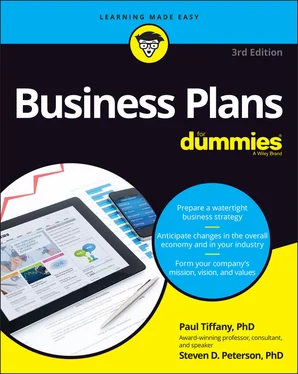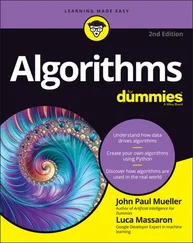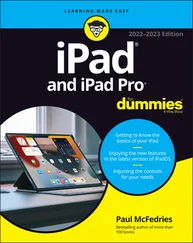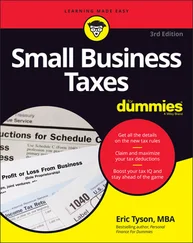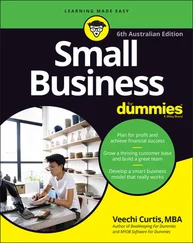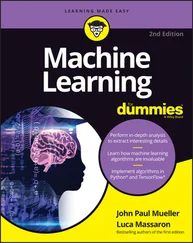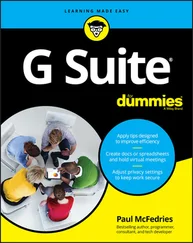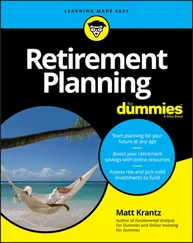Paul Tiffany - Business Plans For Dummies
Здесь есть возможность читать онлайн «Paul Tiffany - Business Plans For Dummies» — ознакомительный отрывок электронной книги совершенно бесплатно, а после прочтения отрывка купить полную версию. В некоторых случаях можно слушать аудио, скачать через торрент в формате fb2 и присутствует краткое содержание. Жанр: unrecognised, на английском языке. Описание произведения, (предисловие) а так же отзывы посетителей доступны на портале библиотеки ЛибКат.
- Название:Business Plans For Dummies
- Автор:
- Жанр:
- Год:неизвестен
- ISBN:нет данных
- Рейтинг книги:4 / 5. Голосов: 1
-
Избранное:Добавить в избранное
- Отзывы:
-
Ваша оценка:
- 80
- 1
- 2
- 3
- 4
- 5
Business Plans For Dummies: краткое содержание, описание и аннотация
Предлагаем к чтению аннотацию, описание, краткое содержание или предисловие (зависит от того, что написал сам автор книги «Business Plans For Dummies»). Если вы не нашли необходимую информацию о книге — напишите в комментариях, мы постараемся отыскать её.
Business Plans For Dummies
Business Plans For Dummies — читать онлайн ознакомительный отрывок
Ниже представлен текст книги, разбитый по страницам. Система сохранения места последней прочитанной страницы, позволяет с удобством читать онлайн бесплатно книгу «Business Plans For Dummies», без необходимости каждый раз заново искать на чём Вы остановились. Поставьте закладку, и сможете в любой момент перейти на страницу, на которой закончили чтение.
Интервал:
Закладка:
In other words, a mission statement answers the basic questions first posed long ago by the famed business guru Peter Drucker:
What business are you in? Who is your customer?
When you conscientiously create a mission statement, you’ll find yourself drilling into the core of your business. Take this example: Home construction toolmaker firms like DeWalt or Makita offer drill bit products to the DIYers who finally gets around to fixing that creaking railing on the back deck. They’re the customers, and the business purpose is the manufacture of metal alloy bits for electric drills — right? Nope. What do these weekend warriors really want? A hole! The drill bit itself is merely a means to an end. Perhaps there’s a looming new laser technology out there that might get the hole-creation task done more efficiently. And the real customer might be the person demanding that the fix-it job finally gets done. If you see yourself only as a shaper and twister of metal for those with lots of nasty little cuts and scrapes on their hands and arms, you’ll likely miss potential competitive threats and focus your marketing efforts on the wrong target.
By understanding the business you’re really in and the customer who truly drives the purchase decision, the firm can address its markets and their needs in a way that better informs the realities they face and decisions they make. A good mission statement will capture this.
 A little preparation up front can make the process a bit easier. Ask yourself some background questions as you get ready to work on your company’s mission statement. Don’t worry if the answers are fairly general at this point, because you’re only interested in the basics right now. Research your goals and the practices of the competition and then answer these questions:
A little preparation up front can make the process a bit easier. Ask yourself some background questions as you get ready to work on your company’s mission statement. Don’t worry if the answers are fairly general at this point, because you’re only interested in the basics right now. Research your goals and the practices of the competition and then answer these questions:
Which customers or groups of customers do you plan to serve?
What products or services do you plan to provide?
What needs do you want to satisfy?
How will your company’s products differ from competing offerings?
What extra value or benefits will customers receive when they choose your company over the competition?
 Need some help? You should enlist managers who are familiar with all the aspects of your business, or if you’re a start-up, call in those advisors who’ve been there before. Follow these steps to begin the process:
Need some help? You should enlist managers who are familiar with all the aspects of your business, or if you’re a start-up, call in those advisors who’ve been there before. Follow these steps to begin the process:
1 Get together a small group of people whose responsibilities cover all the major functions and activities of the company.If you run a small company, include trusted friends, former co-workers, and perhaps even your significant other in this group.
2 Ask the group members to prepare for the meeting by coming up with their own answers to the background questions we list earlier in this section.
3 Review the reasons for having a company mission in the first place, and go over what the mission statement should include.
4 Schedule several informal meetings in which group members can present their own perspectives, brainstorm a bit, and begin to form a consensus.
5 Create, revise, and review the company’s mission statement over as many formal meetings as it takes for everyone to be satisfied with the final product.
A well-crafted mission statement is clear, concise, and easily understood. You should also make it distinctive (from the competition) and up-to-date (given the company’s situation and market dynamics).
 One rock in the road you have to watch out for is “mission creep.” This can occur when the decision-makers forget to stick to the script and get overzealous about what the organization is trying to do, or what they think it can do. As a result, they tack on a little something here, work in a new objective there, and before you know it, end up with a dog’s mess of conflicting goals and underfunded initiatives. It’s worth installing practices and procedures in your own organization that allow for a systematic review of your mission and whether (or not) it’s still guiding your direction. As firms grow and rewards get objectified, some folks in the organization will see opportunities for personal benefit in the scramble for access to scarce resources, no matter how distant the supposed opportunity is from the firm’s core. One good opportunity to call out mission creep is at the annual strategic review session (see Chapter 17).
One rock in the road you have to watch out for is “mission creep.” This can occur when the decision-makers forget to stick to the script and get overzealous about what the organization is trying to do, or what they think it can do. As a result, they tack on a little something here, work in a new objective there, and before you know it, end up with a dog’s mess of conflicting goals and underfunded initiatives. It’s worth installing practices and procedures in your own organization that allow for a systematic review of your mission and whether (or not) it’s still guiding your direction. As firms grow and rewards get objectified, some folks in the organization will see opportunities for personal benefit in the scramble for access to scarce resources, no matter how distant the supposed opportunity is from the firm’s core. One good opportunity to call out mission creep is at the annual strategic review session (see Chapter 17).
Capturing your business ( in 50 words or less)
Your company’s mission statement has to draw a compelling picture of what your business is all about. We often refer to this picture as creating a tangible image of the company. We begin with a first stab at a mission statement:
Our [fill-in your product or service] brings unique value to people, wherever they may be.
Not a bad start. This statement says a little something about geography and a bit about being different. But you’re far from done. To work toward communicating the company’s activities, accomplishments, and capabilities with more clarity and punch, we suggest expanding the statement as follows:
We provide the highest quality [name your product/service] with unmatched value to the global [your product/service] industry, which allows our customers to be leaders in their own fields.
This statement conveys what the company does (provides the highest-quality products or services), who it serves (the relevant global industry), and what sets it apart from its competitors (unmatched value, which allows customers to lead their own fields). This is a far more compelling mission statement than the earlier version.
 How do real companies go about capturing their purpose clearly and concisely, in 50 words more or less? The following examples provide useful insights. If you want more, just key in “mission statement” after naming an organization, and chances are your search engine will crank it out pronto. We may not agree with the composition of each of these. But after reading this chapter up to here, dear reader, and drawing on your own knowledge of the statements under the microscope, we’ll leave it up to you to draw your own conclusions. You even might want to give each a grade, say from one to five with five being the best, and then try to explain to yourself why you awarded that score. Give it a go.
How do real companies go about capturing their purpose clearly and concisely, in 50 words more or less? The following examples provide useful insights. If you want more, just key in “mission statement” after naming an organization, and chances are your search engine will crank it out pronto. We may not agree with the composition of each of these. But after reading this chapter up to here, dear reader, and drawing on your own knowledge of the statements under the microscope, we’ll leave it up to you to draw your own conclusions. You even might want to give each a grade, say from one to five with five being the best, and then try to explain to yourself why you awarded that score. Give it a go.
American Red Cross (an international humanitarian organization): The American Red Cross prevents and alleviates human suffering in the face of emergencies by mobilizing the power of volunteers and the generosity of donors.
Google (leading online search engine firm): Our company mission is to organize the world’s information and make it universally accessible and useful. That’s why Search makes it easy to discover a broad range of information from a wide variety of sources. Some information is purely factual, like the height of the Eiffel Tower. For more complex topics, Search is a tool to explore many angles so you can form your own understanding of the world.
Haas School of Business, University of California-Berkeley: Our mission is to help extraordinary people achieve great things. At Haas, we live our distinctive culture out loud by embracing our four Defining Leadership Principles: Question the Status Quo, Confidence Without Attitude, Students Always, and Beyond Yourself.
Читать дальшеИнтервал:
Закладка:
Похожие книги на «Business Plans For Dummies»
Представляем Вашему вниманию похожие книги на «Business Plans For Dummies» списком для выбора. Мы отобрали схожую по названию и смыслу литературу в надежде предоставить читателям больше вариантов отыскать новые, интересные, ещё непрочитанные произведения.
Обсуждение, отзывы о книге «Business Plans For Dummies» и просто собственные мнения читателей. Оставьте ваши комментарии, напишите, что Вы думаете о произведении, его смысле или главных героях. Укажите что конкретно понравилось, а что нет, и почему Вы так считаете.
